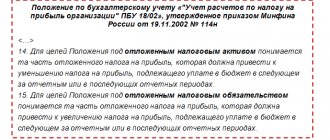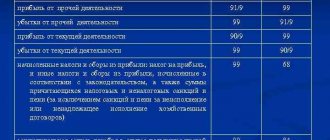All commercial organizations operating according to a system for determining the tax base based on accounting are faced with differences between calculations. This is due to the use of different formulas for calculating financial transactions in taxation and accounting, leading to a difference in amounts called temporary differences . To record information of this nature, the company uses accounting account 77 “Deferred tax liabilities.”
How deferred tax liabilities arise
Deferred tax liabilities arise when permanent or temporary differences arise as a result of different procedures for recognizing income and expenses (profit/loss) in accounting and tax accounting.
Deferred tax liabilities are accounted for in an amount equal to the product of taxable temporary differences and the income tax rate at the reporting date.
Taxable temporary differences in the formation of taxable profit/loss form deferred income tax, which should increase the amount of income tax in subsequent reporting periods when paid to the budget.
Let's look at an example of how deferred tax liabilities are formed.
Let's say from January 2021. JSC "Zern" commissioned new equipment. Its cost was 240,000 rubles, its useful life was four years.
The procedure for recognizing expenses in accounting and tax accounting is as follows:
- Accounting - linear depreciation method, that is, for February = 5,000 rubles, the residual value as of March 1 was 235,000 rubles.
- Tax accounting is a non-linear depreciation method, that is, for February = 10,000 rubles, the residual value as of March 1 was 230,000 rubles.
- Therefore, the taxable temporary difference is RUB 5,000.
What are the consequences of refusing to apply the Order?
This accounting regulation may not apply to non-profit organizations or small businesses. Many accountants confidently do not want to use this Order. They find it confusing, incomprehensible and difficult to understand. Therefore, we have to understand the possible consequences of ignoring the PBU.
In cases where a company refuses to apply PBU, it loses the opportunity to fully or partially not pay income tax in the reporting period. Most likely, in this case, the tax service will file claims against the management and accounting department of the enterprise for gross violations and incorrect accounting entries.
For the responsible person, this may result in a fine of 15 thousand rubles. Also, control authorities can apply a fine for an administrative violation in the range of 2-3 thousand rubles. All such penalties can reach 10% of the payment from the overall distorted picture in accounting.
In all other cases, when PBU is applied fully and legally, possible errors can be completely avoided in both tax and accounting. Guided by this order, most accountants do an excellent job of finding inaccuracies and errors associated with the determination of certain taxes and payments. It also helps to understand the moments and timing of recognition of income and expenses in the reporting period.
Postings to account 77 “Deferred tax liabilities”
Correspondence 77 accounts and entries for accounting for deferred tax liabilities are shown in the table below:
| Dt | CT | Wiring Description | A document base |
| 68 | 77 | Deferred tax reflection | Accounting certificate, Advance payment, Declaration |
| 77 | 68 | Reduction/full repayment of deferred tax reflected | Accounting certificate, Tax registers, Bank statement |
| 99 | 77 | Deferred tax liability written off | Accounting certificate, Tax registers |
Examples of transactions and postings on account 77
Let's look at an example:
- In the second quarter of 2021, Polor LLC (cash method) shipped goods to Vex LLC in the amount of 370,000 rubles, excluding VAT, and received payment - 210,000 rubles, excluding VAT.
- In the third quarter of 2021, the buyer fully repaid its debt to Polor LLC.
- In July of the same year, Polor LLC sold the machine, the accrued depreciation on which amounted to 46,000 rubles in accounting, and 52,000 rubles in tax accounting.
Let's do the calculation:
- income in the accounting records of Polor LLC will be recognized in the amount of 370,000 rubles, and in the tax accounting - in the amount of 210,000 rubles;
- taxable temporary difference – RUB 160,000.
The deferred tax liability for account 77 is reflected in the following entries:
| Dt | CT | Transaction amount, rub. | Wiring Description | A document base |
| 51 | 62 | 210 000 | Partial payment from Veks LLC is reflected | Bank statement |
| 62 | 90.01 | 370 000 | Reflected sales revenue | Packing list |
| 68.04.2 | 77 | 32 000 | Reflection of the increase in tax liability for the 2nd quarter of 2021. | Accounting certificate, Advance payment, Declaration |
| 51 | 62 NVR | 160 000 | Reflected payment from LLC "Vex" | Bank statement |
| 77 | 68.04.2 | 32 000 | Deferred tax liability settled | Accounting certificate, Tax registers, Bank statement |
| 77 | 99 | 1 200 | Reflection of the write-off of the amount of deferred tax liability (machine) | Accounting certificate, Tax registers |
Account 77 » Deferred tax liabilities Postings and Examples
Chart of Accounts Income Tax calculation Income Tax News Tax News
Main items Postings to Fixed Assets Leasing Accounting Account 09 Account 99
Account 77 “Deferred tax liabilities”
Posting Calculation and Examples
Account 09 "Deferred tax asset"
Account 77 of accounting, “Deferred tax liabilities,” collects information on the presence and movement of deferred tax liabilities that arise when calculating income taxes.
Deferred tax liabilities arise when permanent or temporary differences arise as a result of differences in the recognition of income and expenses in accounting and tax accounting.
Deferred tax liabilities (DTL) are accounted for in an amount equal to the product of taxable temporary differences and the income tax rate as of the reporting date:
IT = NVR x 20%
Taxable temporary differences (TDT) when forming profit/loss form deferred income tax, which should increase the amount of income tax in the next period.
Postings:
| No. | Debit | Credit | |
| 1 | Reflects part of the amount of previously recorded IT written off to increase the income of the reporting period | 77 | 68 |
| 2 | Reflects part of the amount of previously recorded IT written off to increase the conditional expense of the reporting period | 77 | 68 |
| 3 | Reflects the amount of IT, which reduces the amount of the conditional expense of the reporting period | 68 | 77 |
| 4 | Reflects the amount of IT, which reduces the amount of conditional income of the reporting period | 68 | 77 |
| 5 | Write-off of IT (accounting certificate) | 99 | 77 |
IT (account 77) corresponds with two accounting accounts - 68 and 99. The received entries reflect the following results:
Dt 68 - Kt 77 - deferred tax, which reduces the amount of income or expense.
Dt 77 - Kt 68 - repayment of deferred tax, formed when income tax is calculated at the end of the reporting period.
Dt 77 - Kt 99 - IT is canceled upon disposal of the asset or circumstance that forms it.
Examples of transactions and postings on account 77
Example 1.
- In the second quarter of 2021, Supplier LLC (operating on a cash basis) shipped goods to Buyer LLC in the amount of RUB 370,000. without VAT and received payment - 210,000 rubles. without VAT.
- In the third quarter of 2021, the buyer fully repaid its debt to Supplier LLC.
Calculation:
- income in the accounting records of Supplier LLC will be recognized in the amount of 370,000 rubles, and in the tax accounting - in the amount of 210,000 rubles;
- taxable temporary difference = RUB 160,000.
IT on account 77 is reflected by the following entries:
| Dt | CT | Transaction amount, rub. | Wiring Description | Base |
| 210 000 | Partial payment from the buyer is reflected | Bank statement | ||
| 370 000 | Reflected sales revenue | Packing list | ||
| 32 000 (370,000 – 210,000) x 20% income tax | Reflection of the increase in tax liability for the 2nd quarter of 2021. | Accounting certificate, Advance payment, Declaration | ||
| 62 Cash Time Time | 160 000 | Payment from buyer reflected | Bank statement | |
| 32 000 | Deferred tax liability settled | Accounting certificate, Tax registers, Bank statement |
What is IT
If expenses in accounting appear later and in greater quantities than in tax accounting, while at the same time income is determined at an earlier date, then conditions arise in the organization for the appearance of IT.
What affects the discrepancy between the calculation of income and expenses in tax and accounting:
— the company’s use of the cash method when accruing tax accounting, that is, receipt of revenue upon shipment of goods before receipt of actual payment;
— differences in calculating depreciation of fixed assets.
The resulting taxable temporary differences (TDT) lead to an increase in tax in the next period.
Example 2.
Supplier LLC sold goods to Buyer LLC for the amount of 170,000 rubles (excluding VAT).
Payment from the buyer was received in the amount of 100,000 rubles.
Supplier LLC uses the cash method when determining tax. The remaining part of the debt was transferred the following year.
At the end of the reporting period, the accountant of Supplier LLC makes the following entries:
Dt 62 - Kt 90 - 170,000 rubles - revenue in accounting for shipped goods;
Dt 51 - Kt 62 - 100,000 rubles - payment from Buyer LLC;
Dt 68 - Kt 77 - 14,000 rubles (debt 70,000 x income tax rate of 20%) - IT is reflected.
When reporting, the amount of 14,000 rubles is reflected in the balance sheet as a deferred income tax liability (IT).
In the subsequent period after closing the debt, the accountant will make the following entries:
Dt 51 - Kt 62 - 70,000 rubles - final payment received from the buyer;
Dt 77 - Kt 68 - 14,000 rubles - IT was repaid.
Fixed Assets
Accrual of depreciation of fixed assets leading to the formation of capital assets
| Initial data | Reflection in accounting | Reflection in tax accounting |
| Purchase of OS, initial cost | 960,000 rubles | 960,000 rubles |
| Depreciation method | Linear | Nonlinear |
| Depreciation group | 3 group | 3 group |
| Accrued depreciation | 20,000 rubles (960,000: 4 years: 12 months) | 53,760 (960,000 x 5.6:100) |
Sometimes there is a discrepancy between actual and planned profits at the moment. The income tax accrued on the income actually received does not coincide with the amount indicated in the tax reporting due to the time difference between the period of accrual and the period of actual payment. The transaction data for account 77 is reflected.
Discrepancies in calculating profits
For tax and accounting purposes. accounting, the moment of making a profit does not always coincide. The unique procedure for accounting for accounting profits often differs from the data on the year-end tax returns.
Such examples are possible, for example, with different methods for calculating depreciation. Accelerated depreciation in tax accounting is unacceptable for accounting. The expenses incurred when determining the taxable base will exceed the expenses in the financial statements.
| ★ Best-selling book “Accounting from scratch” for dummies (understand how to do accounting in 72 hours) > 8,000 books purchased |
Sample of depreciation in different accounts leading to the formation of IT
| Initial data | Reflection in accounting | Reflection in tax accounting |
| Purchase of OS, initial cost | 960,000 rubles | 960,000 rubles |
| Depreciation method | Linear | Nonlinear |
| Depreciation group | 3 | 3 |
| Accrued depreciation | 20,000 rubles (960,000/4 years/12 months) | 53 760 (960 000*5,6/100) |
Taking into account the above conditions, the taxable temporary difference is 53,760 rubles - 20,000 rubles = 33,760 rubles.
Features of account 77
Account 77 is used by income tax payers. It accumulates amounts that must be paid in subsequent tax periods. The term “deferred tax liability” refers to accrued but unpaid income tax, which will actually be transferred after filing reports for a certain period. The deferred tax amount is calculated as temporary accounting differences multiplied by the current tax rate. The amount of accruals must correspond to the data indicated in the tax reporting.
Accounting account 77 is a passive account. The credit of the account takes into account the amount of deferred income tax liabilities, and the debit takes into account the decrease in the amount due to tax payments.
The right not to use this account arises for organizations exempt from paying income tax: organizations using the simplified tax system, UTII, firms related to Skolkovo. It is better to secure this right by an internal local act of the organization.
Basic account information
Account 77 is required for operations related to accounting for deferred tax liabilities. This account belongs to the passive category: a credit records the accumulation of funds from the enterprise’s deferred tax liability, and a debit records tax payment transactions.
Speaking about temporary differences, we mean the profit of the enterprise for the current period, and the tax base for paying the tax - for the next one. If the amount of taxation exceeds the amount of the accounting transaction, then a deferred tax liability (DTL) is formed. Otherwise, they speak of a deferred tax asset.
Account 77 is opened by an enterprise if there is a difference between tax calculations and accounting transactions. It helps to reflect future debts/overpayments of the organization to the State tax authorities. Companies that are not required to pay income taxes are exempt from maintaining account 77 in their financial statements.
If a taxable item is removed from the assets of the enterprise, the deferred tax liability must be written off.
Account 77 – accounting entries
Account 77 reflects the movement of the amount of accrued income tax in correspondence with account 68. Subaccount 01 “Calculations for income tax” is opened to account 68. The tax amount is calculated in the current period and is included in expenses for the current period of time. It is carried out from the debit of account 68.01 to the credit of account 77. The documents on the basis of which data is entered into the account will be:
- tax return,
- accounting certificate-calculation.
On the debit of account 77, the amounts due for repayment of income tax in the current reporting period are posted. The amounts are posted to the credit of account 68.01. The debit is made on the basis of a payment order or bank statement.
In the case of writing off an asset on which tax has been charged, the posting will be made from the debit of account 77 to the credit of account 99. In this case, a sub-account “Write-off of deferred tax liability” is also opened to account 99.
Interaction with other accounts (standard transactions)
Account 77 corresponds with the following accounting accounts:
- 68 — transactions related to the payment of taxes;
- 99—postings to this account are used in cases where a taxable item is written off.
All operations carried out on accounts 77 and 68 are carried out on the basis of supporting documentation: tax returns, certificates of accounting.
Account 77 of accounting is a passive account “Deferred tax liabilities”, collects information on the presence and movement of deferred tax liabilities. Using standard postings and practical examples, we will consider the specifics of using account 77 in accounting.
Account 77 – deferred tax liabilities, example
In the first quarter, the company sold a batch of building materials worth 420,000 rubles. According to the agreement, payment was made in two parts: the buyer paid 200,000 rubles immediately, and paid another 220,000 rubles in the second quarter. Used equipment was also sold, for which depreciation was charged in accounting records of 45,000 rubles, and for tax purposes 53,000 rubles. The amount of tax deferred for payment was 8,000 rubles.
Based on the terms of the agreement, the total amount will be 420,000 rubles, but the actual taxable base at the moment will be equal to 200,000 rubles - the amount paid by the buyer.
In the posting table it will look like this
| Dt | CT | Amount, rub. | Description | Accounting documents |
| 51 | 62 | 200 000 | The first part of the payment is reflected | Statement from the bank |
| 62 | 90.01 | 420 000 | Total revenue | Invoice |
| 68.04 | 77 | 52 000 | Tax increase for the reporting period of the 1st quarter | Declaration, advance payment, bank statement. |
| 51 | 62 | 220 000 | Final payment for goods | Statement from the bank |
| 77 | 68.04 | 52 000 | Repayment of tax amount | Bank statement, accounting certificate |
| 77 | 99 | 8000 | Writing off the amount of tax liability | Certificate from accounting department |
Let's summarize: accounting account 77 is an account that reflects the amounts of taxes planned for payment in the future, but taken into account when calculating the tax base for income tax.
Systematization of accounting
07/24/2018 | no comments
Account 77 “Deferred tax liabilities” is used in the accounting of companies that calculate taxes in accordance with PBU 18/02 to display information about emerging deferred tax liabilities.
Account 77 in accounting is a highly specialized account, designed exclusively to concentrate information about all emerging debts to the budget in terms of taxation of the company's profits, the payment of which will be carried out in the future. These debts arise due to the occurrence of temporary differences.
Deferred tax liabilities mean that part of the income tax, the payment of which to the budget is transferred to subsequent transfers. That is, these are amounts determined by calculation, which will subsequently lead to an increase in tax, or compensation for previously underpaid debt. This value is determined as the quotient of the product of existing taxable temporary differences that arose or were settled in the reporting period by the income tax rate (20% in 2016-2017).
Temporary inconsistencies may appear in a company’s accounting in the following situations:
- Various methods have been recorded for calculating depreciation of existing equipment for accounting and tax accounting (for example, linear and non-linear methods).
- Different times for taking into account the company's revenue received.
- Inconsistency in the time of acceptance of calculated vacation pay, etc.
The company bought an expensive machine, the price is 1 million rubles, the useful life will be 12 years. The accounting policies record different methods for calculating depreciation; the difference between the calculations was determined to be 150 thousand rubles.
How IT appears
Accounting account 77 was created to consolidate information about the presence, as well as the movement of deferred liabilities.
It is included in the accounting records of companies that pay income tax. The procedure for accounting for IT is described and legally regulated by PBU 18/02 “Accounting for calculations of corporate income tax”, and the rules for using account 77 itself are regulated by the chart of accounts. IT appears due to the fact that the method of calculating a company’s income and its expenses differs in accounting and tax accounting. This is where permanent or temporary differences arise.
Permanent differences are not taken into account in calculating the amount payable for tax, which is why they have that name. The reasons for their occurrence:
- non-deductible expenses for property acquired free of charge;
- transfer to subsequent periods of a loss that cannot be taken into account due to the fact that the statute of limitations has expired.
Temporary differences subject to tax, due to which IT appears, occur in the following situations:
- acceptance for accounting of revenue received in carrying out the main activity during the period specified for the report, as well as income from interest using the accrual method for accounting and the cash method for taxation;
- the difference in methods for calculating depreciation in the accounting and tax accounting of an organization;
- different ways of recording interest paid on credits (loans), in tax and accounting.
In addition to those listed, depending on the specifics of the organization, other similar differences may appear.
Account 77 “Deferred tax liabilities” in accounting
The company's profit before tax is 700 thousand rubles, the taxable base, taking into account the discrepancy in depreciation charges, is 550 thousand rubles.
The base mismatch is temporary, because After 10 years, full depreciation will be carried out in both types of accounting.
The resulting transferred tax liability = 150 thousand rubles. * 20% = 30000.
Account 77 is passive. For the loan, the calculated amount to be transferred to the budget is displayed, which allows you to reduce the amount of the financial result of the reporting period, the obligation to pay is transferred to future payments. The debit of the account includes information about the reduction of transferred debts or their full repayment against the calculated income tax for a given period. Transactions are displayed in correspondence with the account. 68.
When disposal of fixed assets, the transferred tax liability calculated on it is written off from the company's records. The write-off occurs for the amount by which the tax base for profits of both the reporting and subsequent periods will not be changed (carried out in Dt99).
Since the account is highly specialized, a certain number of transactions are carried out on it. Account 77, according to the instructions to the Chart of Accounts, corresponds only with the account. 68 (accounting for taxes and fees) and 99 (profits and losses):
- Appearance of transferred tax liability in accounting:
- Movement of previously calculated amounts (for example, an increase in current tax by previously deferred debts):
- Cancellation of an existing tax liability as a result of equipment write-off:
Victor Stepanov, 2017-07-13
>Questions and answers on the topic
No questions have been asked about the material yet, you have the opportunity to be the first to do so
Save the article to social networks:
What are tax differences
In order to take into account the mentioned differences in accounting, account 77 “Deferred tax liabilities” is used. To decide how to handle this aspect of accounting, you need to understand what taxable differences are.
They can be:
- Permanent.
- Temporary.
Permanent differences will never be used to calculate income taxes, which is why they are called permanent differences. They can occur for a number of reasons:
- expenses on property received free of charge are not recognized for accounting purposes;
- a loss carried forward to future periods can no longer be taken into account due to the expiration of the period.
Temporary taxable differences can be used to calculate income taxes in the current or future periods. The temporary difference arises due to certain differences between accounting and tax accounting:
- depreciation of fixed assets in tax is greater than in accounting due to different methods of calculation;
- the company credited the proceeds from the sale of goods, but did not actually receive any cash;
- The methodology for calculating interest on loans varies in accounting.
Note from the author! Temporary differences must be positive to be reflected in deferred receivables.
Temporary differences
Temporary differences are considered to be income or expenses that form an accounting profit or loss during one reporting period, and the tax base for income tax is taken from another or other periods.
Temporary differences can have different effects on the amount of profit or loss, depending on their nature and influence they can be classified:
Temporary differences with deduction
This type of difference means the creation of deferred income tax, which will lead to a decrease in the tax base in the next or subsequent reporting periods. In other words, this leads to the formation of OTA - a deferred tax asset. To bring accounting movements in order, account 09 (deferred tax assets) should be used.
When creating an accounting entry, the amount of income tax in the accounting period will approach this value only for the tax reporting period. In subsequent months, it will be possible to carry out full or partial repayment of OTA to reduce or increase conditional income and expenses.
Temporary tax differences
Taxable differences in the formation of profit and loss for the purpose of calculating income tax lead to the creation of IT (deferred tax liability). Using this method, the tax base in the reporting period is reduced, and for subsequent periods it will increase due to the transfer of payment.
To put accounting entries in order when it moves, accounting account 77 (deferred tax liabilities) is used.
In analytical accounting, each temporary difference must be taken into account individually depending on the group of assets or liabilities. Simply put, all deferred tax liabilities cannot be aggregated into one single netting.
How are liabilities accounted for?
IT accumulations are formed according to the product formula:
Temporary differences * income tax rate in%.
In other words, liabilities (abbreviated as IT) appear if expenses are accepted later in accounting. Income, on the contrary, is recognized earlier. Therefore, they can be considered debt.
How is IT formed?
For example, an organization calculates depreciation in accounting using a linear method, but in tax accounting using a non-linear method. Let’s say a company bought a fixed asset “High-voltage line” worth 200,000 rubles. Since it costs more than 100,000, it is legally subject to depreciation in tax accounting, according to Art. 256 Tax Code of the Russian Federation.
According to the OKOF directory, according to which organizations are required to determine depreciation periods, high-voltage lines are classified as the 10th depreciation group, which means that the useful life is set at 361 months (30 years * 12). Since accounting uses the straight-line method, depreciation is calculated as follows:
200,000 / 361 months = 554.02.
This means that 554.02 rubles of depreciation charges will be written off monthly from the cost of the object. In turn, the 10th group assumes a monthly depreciation rate of 0.7% under Article 259.2 of the Tax Code of the Russian Federation:
200 000 * 0,7% = 1 400.
This means that every month depreciation deductions in the amount of 1,400 rubles are written off in tax accounting.
| Data | Accounting | Tax accounting |
| Purchasing an OS, cost | 200 000 | 200 000 |
| Method of calculating depreciation | Linear | Nonlinear |
| Depreciation group | ||
| Formula for calculating depreciation | 200,000 / 361 months | 200 000 * 0,7% |
| Depreciation accrued | 554,02 | 1 400 |
Thus, you can find the temporary taxable difference:
1,400 - 554.02 = 845.98 rubles.
The difference amounts will be credited to the 77th ONO account as follows:
845.98 * 20% = 169.20 rubles,
where 20% is the total income tax rate, taking into account the federal and regional shares. In this case, the following wiring should occur:
Debit 68.4 “Calculations for income tax” Credit 77 - 169.20 rubles.
Note from the author! The income tax rate and distribution by shares are regulated by law depending on the type of activity and the region of residence of the organization.
Change in deferred liabilities
According to the Chart of Accounts, adopted by law, movements in account 77 are strictly prescribed within certain limits. Operations on it can be performed to increase or decrease the indicator.
When IT is completely repaid or reduced, the following posting is made:
Debit 77 “Deferred liabilities” Credit 68.4 “Calculations for income tax.”
When the value of debts increases in addition to income tax, the following entry is made:
Credit 77 “ONO” Debit 68.4 “Calculations for income tax.”
If IT is removed from the balance sheet of the enterprise, then the posting will be as follows:
Debit 77 “Deferred liabilities” Credit 99 “Profits and losses”.
In this case, it is necessary to write off not only the amount of debt, but also the temporary difference.
For example, an organization sold a gas boiler. At the time of sale, the amount of accrued depreciation was:
- 400,000 rubles in tax accounting;
- 350,000 rubles in accounting.
Savings on ONO in the 77th account:
- 400,000 - 350,000 = 50,000 rubles;
- 50,000 * 20% = 3,000 rubles.
This means that the following must be written off from the balance sheet:
- Debit 77 Credit 99 “Profits and losses” - 3,000 for the amount of the deferred liability.
Consultations from experts of the Legal Consulting Service GARANT
As of December 31, 2017, there is a balance on accounts 77 and 09. For example, on account 77: recorded differences in work in progress, deferred expenses, differences in the valuation of own-produced products, and more.
On account 09 - differences in reserves for vacations and other things.
The assets for which the differences arose currently continue to remain on the balance sheet.
Having considered the issue, we came to the following conclusion:
Depending on the professional judgment of the accountant, the balance on accounts 09 and 77 can be written off either to account 84 “Retained earnings (uncovered loss)” or to account 99 “Profits and losses”.
Rationale for the conclusion:
In accordance with paragraph 3 of PBU 18/02 “Accounting for calculations of corporate income tax” (hereinafter referred to as PBU 18/02), the difference between accounting profit (loss) and taxable profit (loss) of the reporting period resulting from the application of various recognition rules income and expenses, which are established in regulatory legal acts on accounting and the legislation of the Russian Federation on taxes and fees, consists of permanent and temporary differences.
For the purposes of PBU 18/02, temporary differences are understood as income and expenses that form the accounting profit (loss) in one reporting period, and the tax base for income tax in another or other reporting periods (clause 8 of PBU 18/02).
The part of the deferred income tax, which should lead to a decrease (increase) in income tax payable to the budget in the next reporting period or in subsequent reporting periods, is recognized as a deferred tax asset (deferred tax liability) (clauses 14, 15 of PBU 18/02).
Instructions for the application of the Chart of Accounts for accounting financial and economic activities of organizations, approved by order of the Ministry of Finance of the Russian Federation dated October 31, 2000 N 94n (hereinafter referred to as the Instructions), stipulate that accounts 09 are intended to summarize information on the presence and movement of deferred tax assets and deferred tax liabilities. “Deferred tax assets” and 77 “Deferred tax liabilities”.
Based on clauses 17, 18 PBU 18/02, a deferred tax asset (deferred tax liability) upon disposal of the asset (liability) for which it was accrued (it was accrued), is written off in an amount by which, according to the legislation of the Russian Federation on taxes and fees, will not be reduced ( increased) taxable profit for both the reporting period and subsequent reporting periods.
In turn, the Instructions indicate that upon disposal of an asset (liability) for which it was accrued (it was accrued), the deferred tax asset (deferred tax liability) is written off from the credit of account 09 (debit of account 77) to the debit (credit) of the account 99 "Profits and losses."
However, in the case under consideration, there is no disposal of assets (liabilities). Therefore, we can conclude that there are no grounds for applying these provisions of the Instruction.
At the same time, it follows from the question that from 2021 your organization plans to apply new accounting methods that will avoid the formation of deferred tax assets (deferred tax liabilities).
Paragraph 10 of PBU 1/2008 “Accounting Policy of an Organization” (hereinafter referred to as PBU 1/2008) determines that changes to an organization’s accounting policy can be made, in particular, if the organization develops new accounting methods. The use of a new method of accounting involves improving the quality of information about the accounting object.
Similar wording is contained in clause 2 of part 6 of Art. 8 of the Federal Law of December 6, 2011 N 402-FZ “On Accounting”.
However, accounting legislation does not clarify what is meant by improving the quality of information about an accounting object.
The financial department also does not establish criteria for improving the quality of information.
Considering the above, we believe that an organization should independently, taking into account the professional judgment of an accountant, determine whether a change in accounting methodology leads to a more correct from an economic point of view formation and, accordingly, reflection of the value of work in progress, the actual cost of inventories, etc.
In this case, your organization should be guided by clause 15 of PBU 1/2008, which provides that, as a general rule, the consequences of a change in accounting policy caused by reasons that have had or could have a significant impact on the financial position of the organization, the financial results of its activities and (or) the movement funds are reflected in the financial statements retrospectively, except for cases where the assessment in monetary terms of such consequences in relation to periods preceding the reporting period cannot be made with sufficient reliability (letter of the Ministry of Finance of Russia dated 03/01/2017 N 07-01-09/11342) .
When retrospectively reflecting the consequences of changes in accounting policies, we proceed from the assumption that the changed method of accounting was applied from the moment the facts of economic activity of this type arose. Retrospective reflection of the consequences of changes in accounting policies consists of adjusting the opening balance under the item “Retained earnings (uncovered loss)” and (or) other balance sheet items as of the earliest date presented in the accounting (financial) statements, as well as the values of related accounting items disclosed for each period presented in the financial statements, as if the new accounting policy had been applied from the moment the facts of economic activity of this type arose.
Taking into account the above, we believe that the indicated write-off of the balance on accounts 09 and 77 is reflected in the following entries:
Debit 84 Credit 09
— the amount of the deferred tax asset is written off;
Debit 77 Credit 84
— the amount of deferred tax liability is written off.
We believe that such a write-off can be carried out in the reporting period, that is, in 2021, when forming an account balance of 84.
At the same time, if a change in accounting methodology does not entail an improvement in the quality of information about accounting objects, then in this case the balance on accounts 09 and 77 will be written off simultaneously with the disposal of the assets for which they were accrued. In this case, the following entries will be made in accounting:
Debit 99 Credit 09
— the amount of the deferred tax asset is written off;
Debit 77 Credit 99
— the amount of deferred tax liability is written off.
Typical situations
In this case, the credit balance of account 77 is displayed in expanded form in line 1420 and the debit balance from account 09 “Deferred tax assets” in the balance sheet asset on line 1180 of the “Non-current assets” section.
The collapsed view assumes a decrease in the credit balance of the 77th account by the debit of the 09th account.
Note from the author! If the income tax rate changes, the deferred liabilities must be recalculated in accordance with the change. The change in value is reflected in the balance sheet in the year following the reporting year. This circumstance is stipulated by PBU 18/02.
The content of the 1420 balance line is one of the most difficult aspects to understand and requires a good understanding of the differences. Incorrectly reflected amounts are fraught with arrears, fines and, accordingly, a full measure of liability.
>Questions and answers on the topic
No questions have been asked about the material yet, you have the opportunity to be the first to do so
Save the article to social networks:
In this case, the following entries are made in accounting:
- when writing off IT - by the debit of account 99 in correspondence with the credit of account 09 “Deferred tax assets”;
- when writing off IT - by debiting account 77 “Deferred tax liabilities” in correspondence with the credit of account 99.
Written off SHE and IT affect the amount of net profit (loss) for accounting purposes.
Let us give a formula for calculating net profit (loss), from which this will be clear. —————————————————————————————————————————————————— ———————————————¬ | Net profit (loss) of the reporting period (line 190 of the Profit and Loss Statement) | L————————————————————————————————————————————————— ———————————————— = ————————————————————————————————— —————————————————————————————————¬ | Profit (loss) before tax (line 140 of the Profit and Loss Statement) | L————————————————————————————————————————————————— ———————————————— + ————————————————————————————————— —————————————————————————————————¬ | Deferred tax assets (line 141 of the Profit and | | Loss Statement) = Difference between debit and credit turnover by | | account 09 in correspondence with account 68 for the reporting period | L————————————————————————————————————————————————— ———————————————— — ————————————————————————————————— ————————————————————————————————- | Deferred tax liabilities (line 142 of the Profit and Loss Statement) = Difference between credit and debit turnover by | | account 77 in correspondence with account 68 for the reporting period | L————————————————————————————————————————————————— ———————————————— — ————————————————————————————————— —————————————————————————————————¬ | Current income tax (line 150 of the Profit and | | Loss Statement) = Line 180 of sheet 02 of the Income Tax Declaration | | organizations for the reporting period | L————————————————————————————————————————————————— ———————————————— — ————————————————————————————————— —————————————————————————————————¬ | Deferred taxes written off during the reporting period | | assets upon disposal of objects for which these deferred| | tax assets (shown on the free line of the Statement of | | profit and loss after the current income tax + —————————————————————————————— ———————————————————————————————————¬ | Deferred tax liabilities written off during the reporting period | | liabilities upon disposal of assets , for which these | | deferred tax liabilities arose (shown on the free | | line of the Profit and Loss Statement after the current tax on | | profit +/- —————————————————— ———————————————————————————————————————————————¬ | Recalculation for income tax (for example, errors of previous years | | when calculating income tax) and payments from profit | | (for example, tax sanctions) (shown on free lines | | of the profit and loss statement after the current tax on | | profit)
Please note the fact that
> the amount reflected on account 99 as a result of writing off ONA or ONO upon disposal of the object
according to which they are calculated,
does not participate in the formation of accounting profit (loss) before tax
, from which the conditional income tax expense (income) is calculated.
The current income tax for the reporting period, reflected on line 150 of the Profit and Loss Statement, is the income tax calculated according to tax accounting data and shown on line 180 of sheet 02 of the Organizational Income Tax Declaration for the reporting period. If permanent tax assets and liabilities, as well as deferred taxes are correctly accounted for in accounting, then current income tax can also be calculated using the following formula








